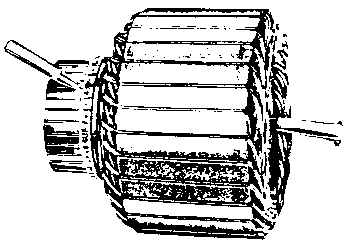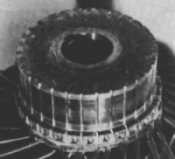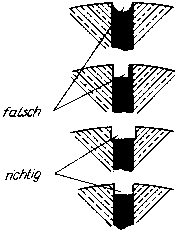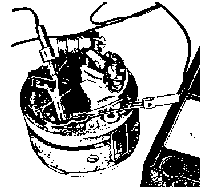 |
Dynamo - Testing Components
|
[ Home ] [ MZ Links ] [ MZ Main Index ] [ Search Site ] [ Join The MZ Riders ]
Testing the Armature,
testing the Field
Coils ,
Servicing the Commutator.
The Dynamo
The electricity required for the normal running of the bike is derived from
the generator or dynamo. This is a rotating device which utilizes the principle
of electro-magnetic induction.
Around any magnet there is a field of magnetic influence, and if a wire is
caused to move within this field a voltage is set up across the ends of the
wire, so that when the ends are joined by an external circuit a current will
flow.
In a dynamo there are a large number of moving wires, mounted in coils on a
rotor known as the armature which revolves in between and very close to, the
poles of an electromagnet. The internal connections of the dynamo are such that
the voltage induced in the rotating armature coils is applied to the stationary
field coils. So that, in effect, the dynamo provides it's own magnet.
The voltage is "picked off" the armature by means of carbon blocks
or brushes which press on to a drum mounted at one end, known as the commutator.
This consists of a number copper strips close together to form a cylinder, with
mica insulation between the strips. The commutator also ensures a unidirectional
(DC) flow of current.
Obviously, if there is a defect within any of these components then the
dynamo will be less efficient or will not work at all.
Back
to Top
Testing the Armature
 The armature can be tested for earth faults and shorted turns. One end of a
continuity tester (multimeter set to measure resistance, ohms) is applied to
earth and the other is touched against each of the commutator strips in turn.
The armature can be tested for earth faults and shorted turns. One end of a
continuity tester (multimeter set to measure resistance, ohms) is applied to
earth and the other is touched against each of the commutator strips in turn.
If there is continuity to earth then there is a fault.
To test the armature for shorted turns, clean and service the commutator (detailed
below) , this is to ensure that none of the segments are connected with each
other.
When the armature is removed from the engine check that there is no continuity
between segments.
Back
to Top
Servicing the Commutator
 The
commutator surface should be clean and bright, slight scratches and discolouring
can be removed with wire wool or emery paper and a little metal polish. Ensure
all polish etc. is removed. Deep scratches/ridges require the commutator to be
turned in a lathe. The mica should be under cut (use a fine hacksaw blade) by
0.2 - 0.4 mm to a maximum width of 0.7 mm. The
commutator surface should be clean and bright, slight scratches and discolouring
can be removed with wire wool or emery paper and a little metal polish. Ensure
all polish etc. is removed. Deep scratches/ridges require the commutator to be
turned in a lathe. The mica should be under cut (use a fine hacksaw blade) by
0.2 - 0.4 mm to a maximum width of 0.7 mm.
falsch = wrong
richtig = correct |
 |
Back
to Top
Testing the Field Coils
 Before testing for leakage to earth disconnect the adjustable resistor from the
main body.
Before testing for leakage to earth disconnect the adjustable resistor from the
main body.
Like the armature, the field coils are checked with a continuity tester. If
there is continuity between DF and earth then there is a short within the field
coils. These can only be repaired/replaced by a specialist.
To test for shorted turns an Ohmmeter is required. The two probes are connected
to positive and negative sides of the field coil, the reading should be between
1.7 to 2.1 ohm. If the reading is below 1.7 ohm, the turns are shorted. If the
needle fails to deflect (no continuity) the coils are interrupted.
Back
to Top
|
 The armature can be tested for earth faults and shorted turns. One end of a
continuity tester (multimeter set to measure resistance, ohms) is applied to
earth and the other is touched against each of the commutator strips in turn.
The armature can be tested for earth faults and shorted turns. One end of a
continuity tester (multimeter set to measure resistance, ohms) is applied to
earth and the other is touched against each of the commutator strips in turn. The
commutator surface should be clean and bright, slight scratches and discolouring
can be removed with wire wool or emery paper and a little metal polish. Ensure
all polish etc. is removed. Deep scratches/ridges require the commutator to be
turned in a lathe. The mica should be under cut (use a fine hacksaw blade) by
0.2 - 0.4 mm to a maximum width of 0.7 mm.
The
commutator surface should be clean and bright, slight scratches and discolouring
can be removed with wire wool or emery paper and a little metal polish. Ensure
all polish etc. is removed. Deep scratches/ridges require the commutator to be
turned in a lathe. The mica should be under cut (use a fine hacksaw blade) by
0.2 - 0.4 mm to a maximum width of 0.7 mm.
 Before testing for leakage to earth disconnect the adjustable resistor from the
main body.
Before testing for leakage to earth disconnect the adjustable resistor from the
main body.